New Topics
Published Paper (page 4) (2008-2011)
"Visualization of Three-Dimensional MHD Simulation Data to Study Fine
Unstable Motions in a Helical Torus Device"
H. Miura,
IEEE TRANSACTIONS ON PLASMA SCIENCE, Vol.39, 2011
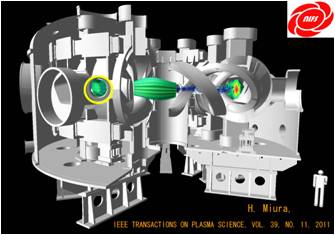
Isosurfaces of the pressure in a 3D MHD simulation of a hot magnetized
plasma dominated by the ballooning instability are visualized. The flute-like
structures of the isosurfaces indicates growth of the ballooning mode.
The yellow circle indicates the tangential port of the LHD. |
"Equilibria of toroidal plasmas with toroidal and poloidal Flow in
high-beta
reduced magnetohydrodynamic models"
A. Ito and N. Nakajima,
Nuclear Fusion Vol.51, 123006 (2011)
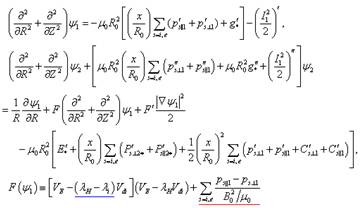
Grad-Shafranov type equations for high-beta toroidal equilibria with toroidal
and poloidal flow, two-fluid and finite Larmor radius effects and pressure
anisotropy. |
"Scientific Visualization of Plasma Simulation Results and Device Data in Virtual-Reality Space"
H. Ohtani, Y. Tamura, A. Kageyama, and S. Ishiguro,
IEEE Transactions on Plasma Science Special Issue - Images in Plasma Science
2011, Vol.39 (11) 2472-2473 (2011)
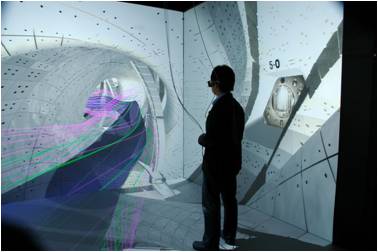
Scientific visualization of the equilibrium plasma in the Large Helical
Device (LHD) with the realistic description by the virtual-reality system
`CompleXcope.' Blue surface shows the isosurface of plasma pressure. Green
and magenta lines are the single magnetic-field line and single particle
orbit, respectively. |
"Hybrid Simulation between Molecular Dynamics and Binary Collision
Approximation Codes for Hydrogen injection into Carbon Materials"
S. Saito, A. M. Ito, A. Takayama, T. Kenmotsu, and H. Nakamura,
Journal of Nuclear Materials, doi:10.1016/j.jnucmat.2010.12.233, (2011)
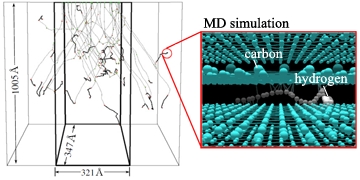
The left panel shows thirty trajectories of incident hydrogen that moves
in a graphite material calculated by BCA-MD hybrid simulation. The gray
and black lines in the left panel are obtained by the binary collision
approximation (BCA) and the molecular dynamics (MD) simulation, respectively.
The right panel shows a detailed image of the MD simulation part. |
"Multi-scale simulation for plasma science"
S. Ishiguro, S. Usami, R. Horiuchi, H. Ohtani, A. Malukov, and M. M. Skoric,
Journal of physics: Conference Series Vol. 257, 012026 (2010)
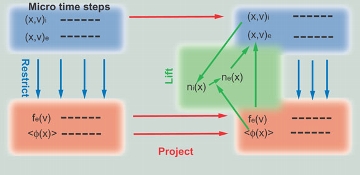
Structure of primal Equation Free Projective Integration PlasmaSimulation. |
"Simulation Data Analysis by Virtual Reality System"
H. Ohtani, N. Ohno, N. Mizuguchi, M. Shoji, and S. Ishiguro,
Plasma and Fusion Research Vol.5, S2109 (2010)
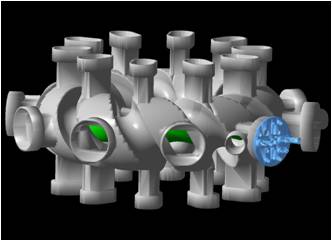
Scientific visualization of both simulation result and experimental device
data. This is the view from outside of LHD vessel device.Simulation result
about LHD is obtained by MHD simulation, and pressure profile is shown
as green isosurface. |
"Simulation of feedback instability in the coupled magnetosphere-ionosphere system"
Hiroki Hasegawa, Nobuaki Ohno, and Tetsuya Sato,
Journal of Geophysical Research Vol.115, A08304 (2010)
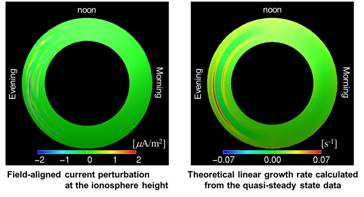
The left panel shows the distribution of the field-aligned current density
perturbation at the ionospheric height, which is obtained by a nonlinear
simulation. The right panel represents the distribution of the linear growth
rate calculated from the quasi-steady state data through the integrated
feedback instability theory. This figure indicates that the areas where
longitudinally striated structures appear are consistent with the prediction
by the theory. |
"Influences of ballooning modes with moderate wave number on MHD equilibrium
in LHD"
H. Miura and N. Nakajima,
Nuclear Fusion Vol. 50, 054006 (2010)
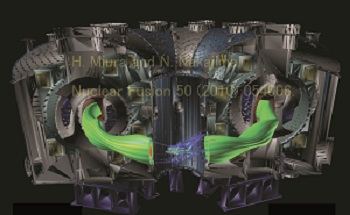
A 3D view of a full-3D MHD simulation of LHD. Contours of the pressure
are drawn on the poloidal cross-section.The red region represents β = p/(B02 /2) = 3.7% , while the green colour is p/(B02 /2) = 1%. |
"Magnetic Reconnection Controlled by Multi-Hierarchy Physics in an
Open System"
R. Horiuchi, S. Usami, H. Ohtani, and T. Moritaka,
Plasma and Fusion Research Vol. 5, S2006 (2010)
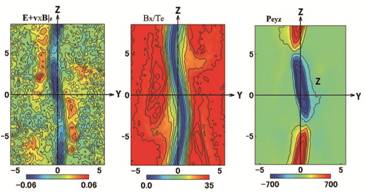
Spatial profiles of E + ve x B (left), Bx/Te (middle), and off-diagonal component of electron pressure tensor Peyz (right) in the (y, z) plane in the presence of drift-kink instability. |
"Improved Open Boundary Model for Plasma Particle Simulations"
Hiroki HASEGAWA and Tetsuya SATO
Plasma and Fusion Research Vol.5, 020 (2010)
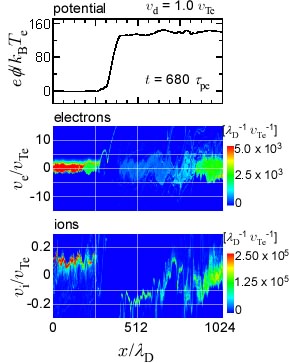
This figure shows the result of a test simulation. The top, middle, and
bottom panels present the spatial profile of electric potential and distributions
of electrons and ions in space-velocity phase space, respectively. This
result indicates that double layer creation by ion-acoustic instability
also occurs in a case where the electron drift velocity is comparable to
the electron thermal velocity. |
"First Demonstration of Collisionless Driven Reconnection in a Multi-Hierarchy Simulation"
S. Usami, H. Ohtani, R. Horiuchi, and M. Den,
Plasma and Fusion Res. Vol.4, 049 (2009)
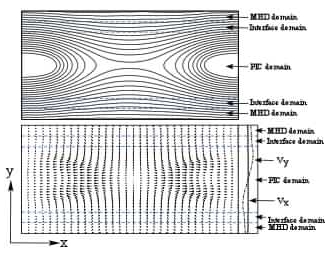
Magnetic lines of force and fluid velocity vectors in a multi-hierarchy
simulation. |
"Equation-Free Coarse Grained Projective Integration Method for Multi-Scale
Plasma Simulation"
ISHIGURO Seiji and SKORIC Milos, M.
J. Plasma Fusion Res. Vol.85, 593-596 (2009)
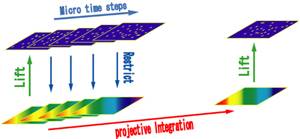
Concept of Equation-Free Projective Integration Method. |
"Relativistic Laser-Plasma Interactions"
Milos M. Skoric
AIP Conf. Proc. Vol.1188, 15-34 (2009)
NEW DEVELOPMENTS IN NONLINEAR PLASMA PHYSICS
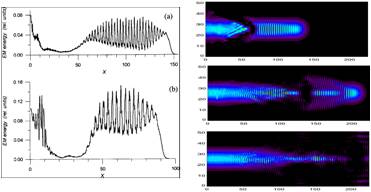
Snapshots of spatial laser pulse energy from 1D Fluid (left) and 2D PIC
(right) simulations show strong spatial modulation, depletion and pulse
break-up due to backward SRS. |
"Generation control of fast electron beam by low density foam for FIREX-I"
H. Sakagami, T. Johzaki, H. Nagatomo, and K. Mima
Nucl. Fusion, Vol.49, 075026 (2009)
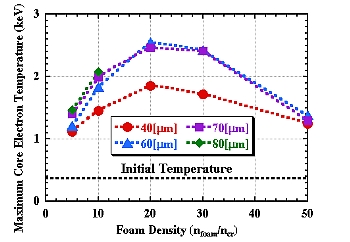
Maximum averaged core electron temperatures as a function of foam density.
Red circle, blue triangle, purple square and green diamond indicate the
foam thickness of 40, 60, 70 and 80 micron, respectively. |
"Open Boundary Condition for Particle Simulation in Magnetic Reconnection Research"
H.Ohtani and R.Horiuchi
Plasma and Fusion Research Vol.4 (2009) 024.
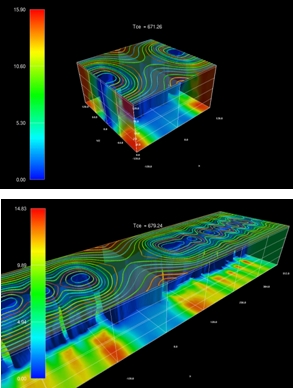
Comparison of the results of short (top) and long (bottom) -simulation boxes to check whether the open boundary condition fulfills its function. The results of the short -simulation box effectively mimic those of the long -simulation box. |
"Analytic high-beta tokamak equilibria with poloidal-sonic flow"
A. Ito and N. Nakajima,
Plasma Phys. Control. Fusion Vol.51, 035007 (2009)
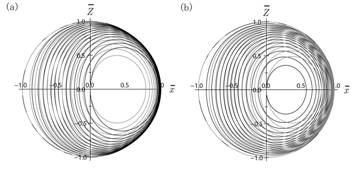
Pressure isosurfaces (black) and magnetic flux surfaces (gray) for (a)
sub-and (b) super-poloidal-sonic flows. |
"Electron Force Balance in Steady Collisionless-Driven Reconnection"
B. Li and R. Horiuchi,
Physical Review Letters Vol.101, 215001 (2008)
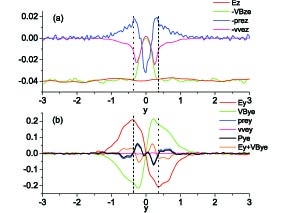
Spatial profiles of each term in the z direction(top) and inflow direction
(bottom) of the electron momentum equation along the vertical line passing
the X point in the steady state. |
|
|
|
 NIFS WEB
NIFS WEB NIFS WEB
NIFS WEB